1. Background
ZooKeeper (ZK) is a distributed application coordination service born in 2007. Although for some special historical reasons, many business scenarios still have to rely on it. For example, Kafka, task scheduling, etc. Especially when Flink mixed deployment and ETCD decoupling, the business side required absolute stability and strongly recommended not to use self-built ZooKeeper. For stability considerations, Alibaba's MSE-ZK is used. Since we started using it in September 2022, we have not encountered any stability problems, and the SLA reliability has indeed reached 99.99%.
In 2023, some businesses used self-built ZooKeeper (ZK) clusters, and then ZK experienced several fluctuations during use. Then Dewu SRE began to take over some self-built clusters and made several rounds of stability reinforcement attempts. During the takeover, we found that after ZooKeeper has been running for a period of time, the memory usage will continue to increase, which can easily lead to out-of-memory (OOM) problems. We were very curious about this phenomenon and therefore participated in the exploration process to solve this problem.
2. Exploration and analysis
determine direction
When troubleshooting the problem, we were very lucky to find a fault site in a test environment. Two nodes in the cluster happened to be in an edge state of OOM.

With the fault scene, usually only 50% is left before the successful end point.
The memory is on the high side. According to past experience, it is either non-heap or there is a problem in the heap. It can be confirmed from the flame graph and jstat that it is a problem in the heap.
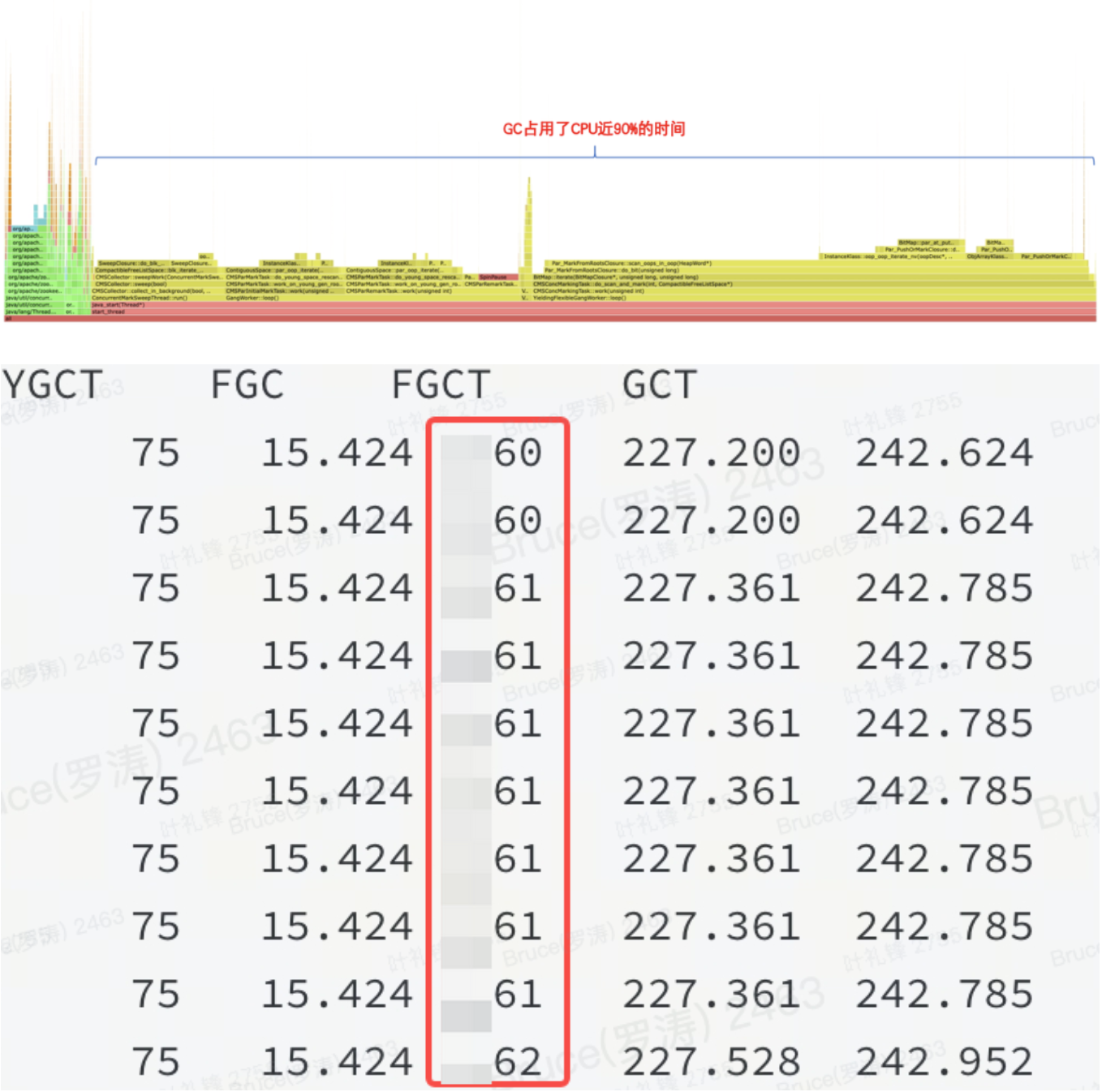
As shown in the figure: It means that a certain resource in the JVM heap occupies a large amount of memory, and FGC cannot release it.
Memory analysis
In order to explore the memory usage distribution in the JVM heap, we immediately made a JVM heap dump. Analysis found that JVM memory is heavily occupied by childWatches and dataWatches.
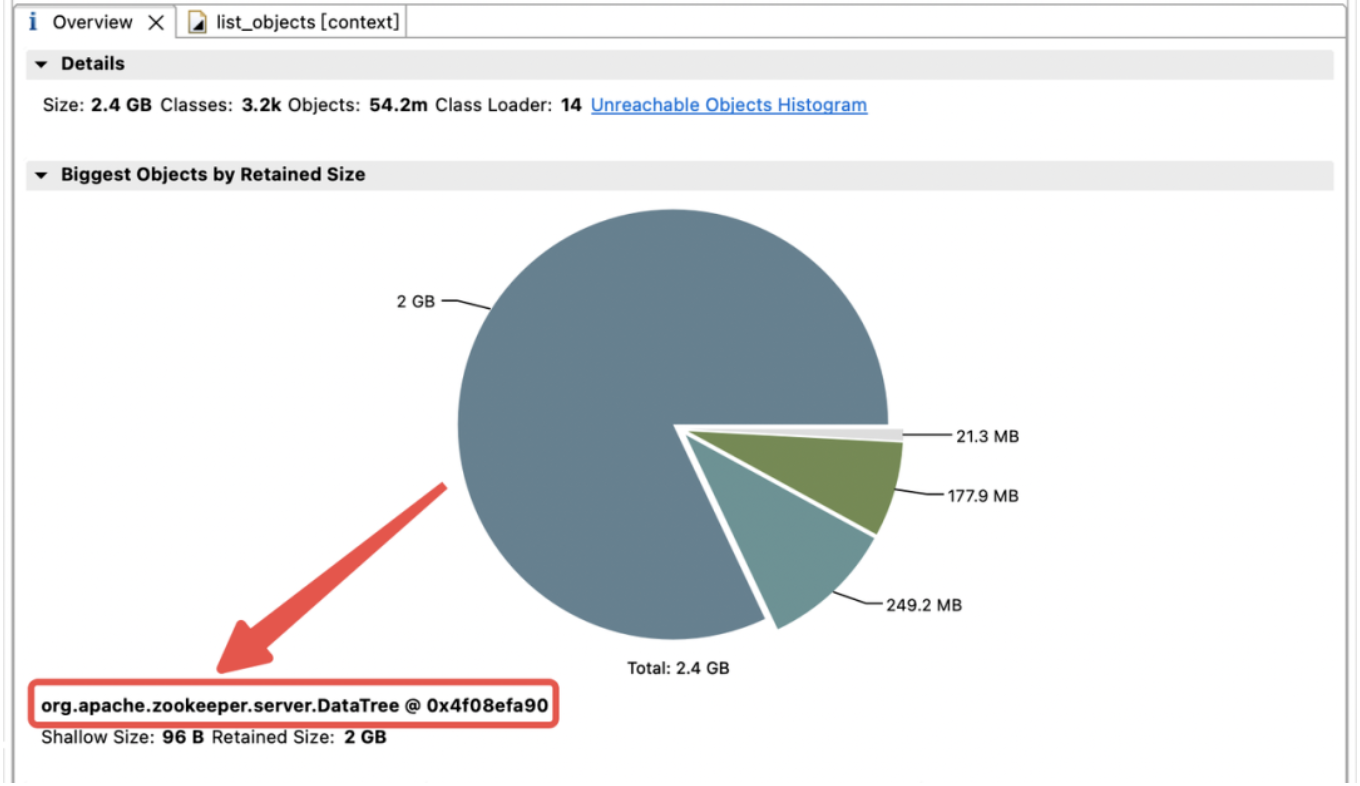
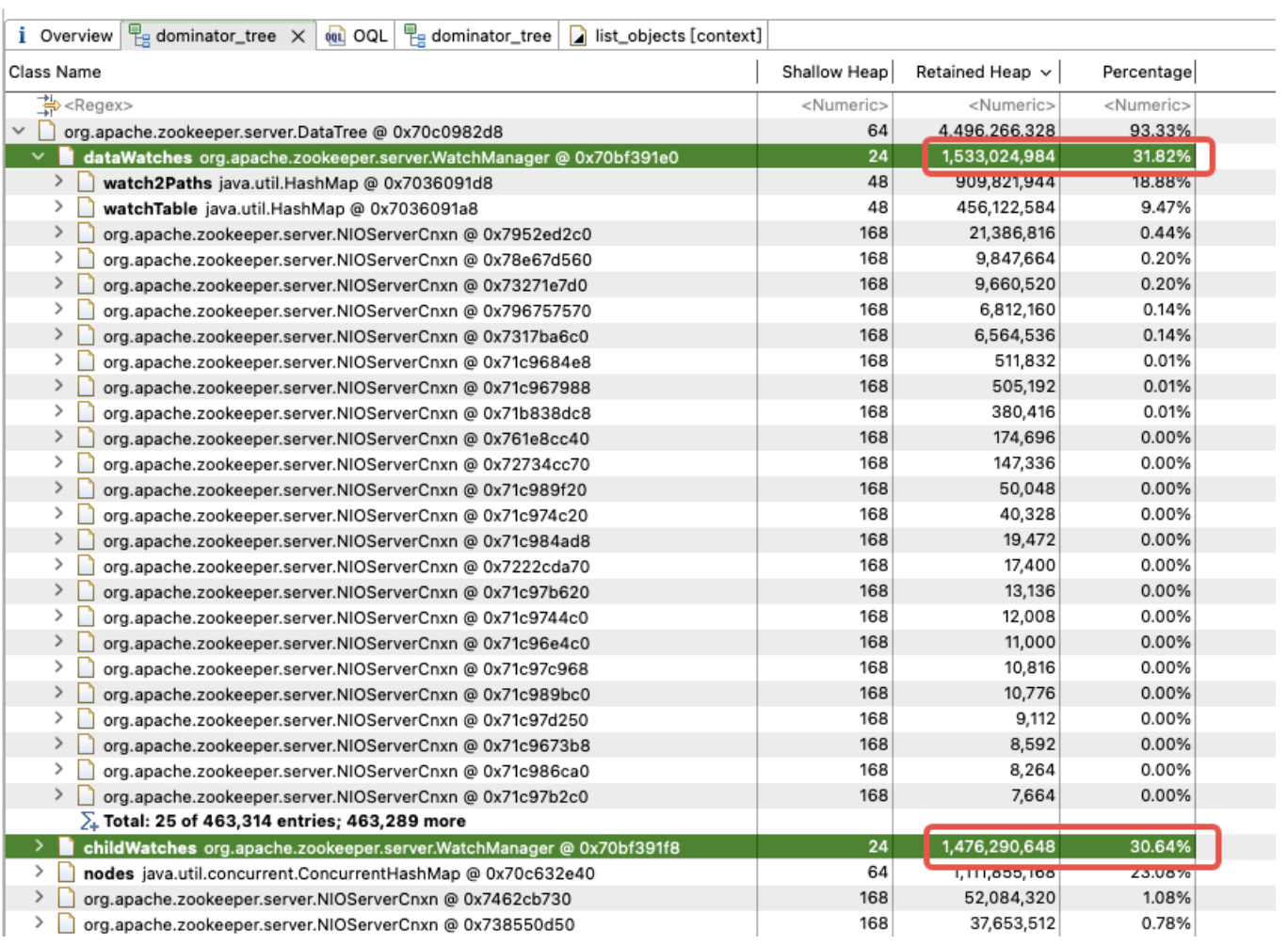
dataWatches: Track changes in znode node data.
childWatches: Track changes in the znode node structure (tree).
childWatches and dataWatches have the same origin as WatcherManager.
After data investigation, we found that WatcherManager is mainly responsible for managing Watchers. The ZooKeeper (ZK) client first registers Watchers to the ZooKeeper server, and then the ZooKeeper server uses WatcherManager to manage all Watchers. When the data of a Znode changes, WatchManager will trigger the corresponding Watcher and communicate with the socket of the ZooKeeper client subscribed to the Znode. Subsequently, the client's Watch manager will trigger the relevant Watcher callback to execute the corresponding processing logic, thereby completing the entire data publishing/subscribing process.
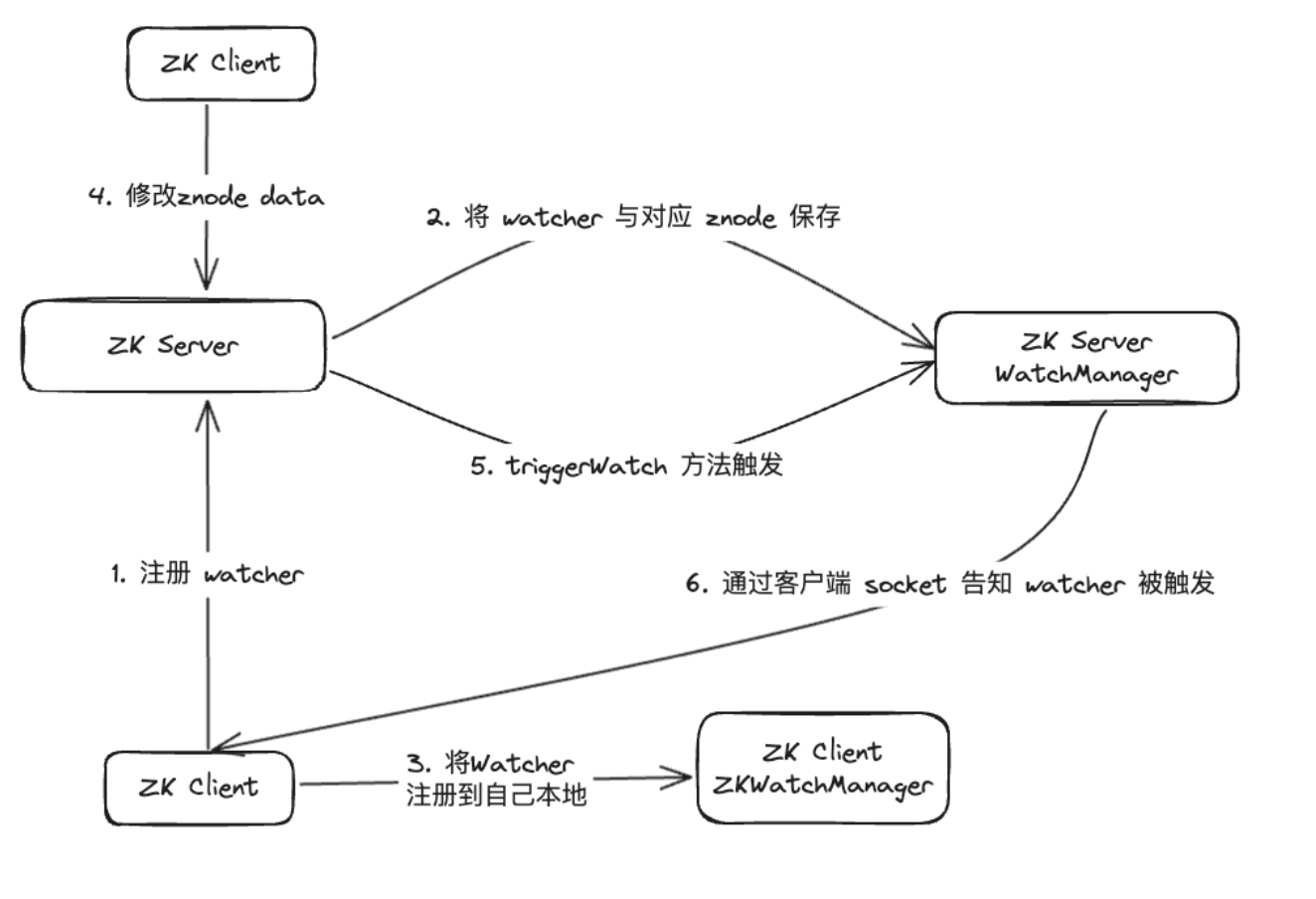
Further analysis of WatchManager shows that the memory ratio of member variables Watch2Path and WatchTables is as high as (18.88+9.47)/31.82 = 90%.
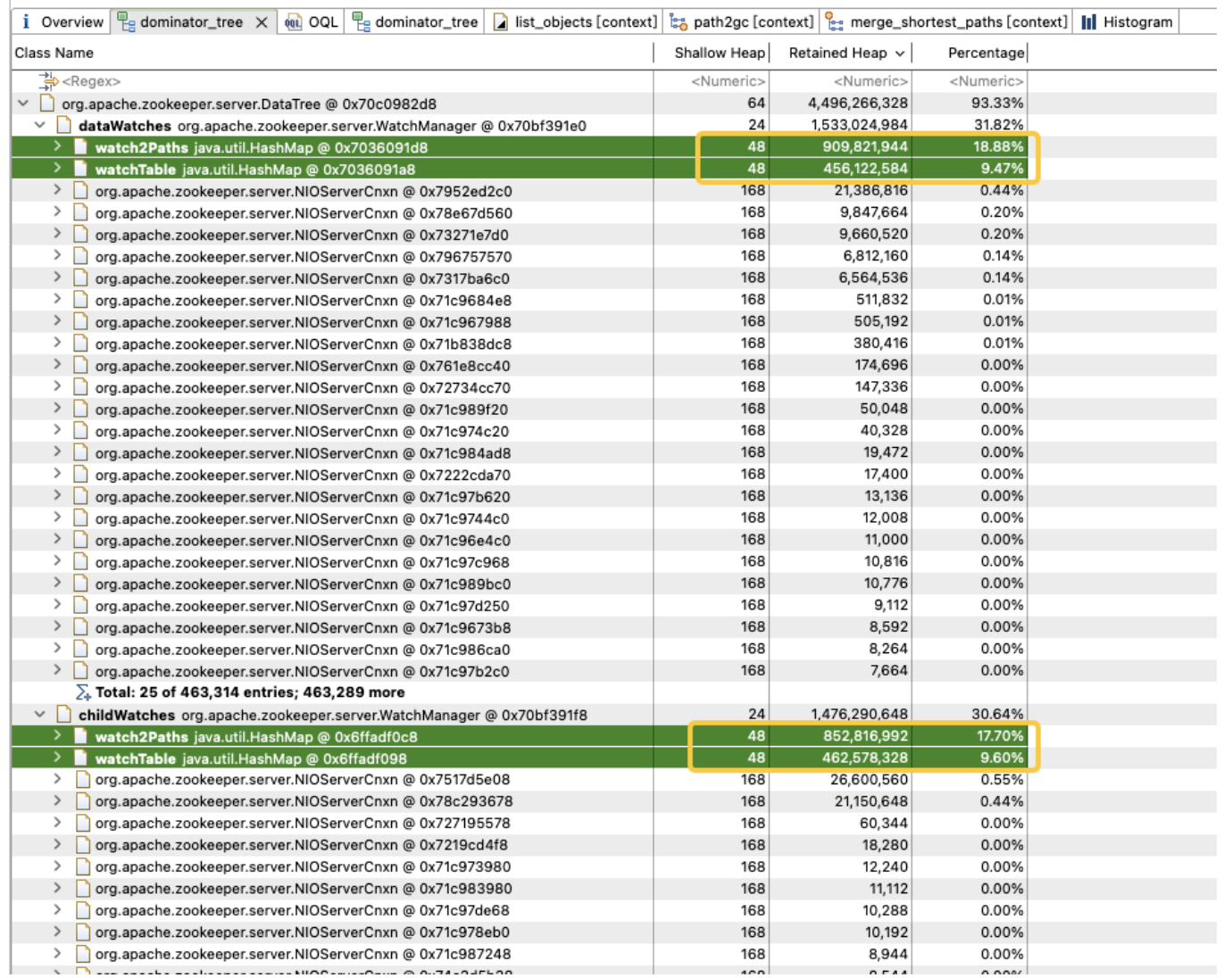
WatchTables and Watch2Path store the exact mapping relationship between ZNode and Watcher, as shown in the storage structure diagram:
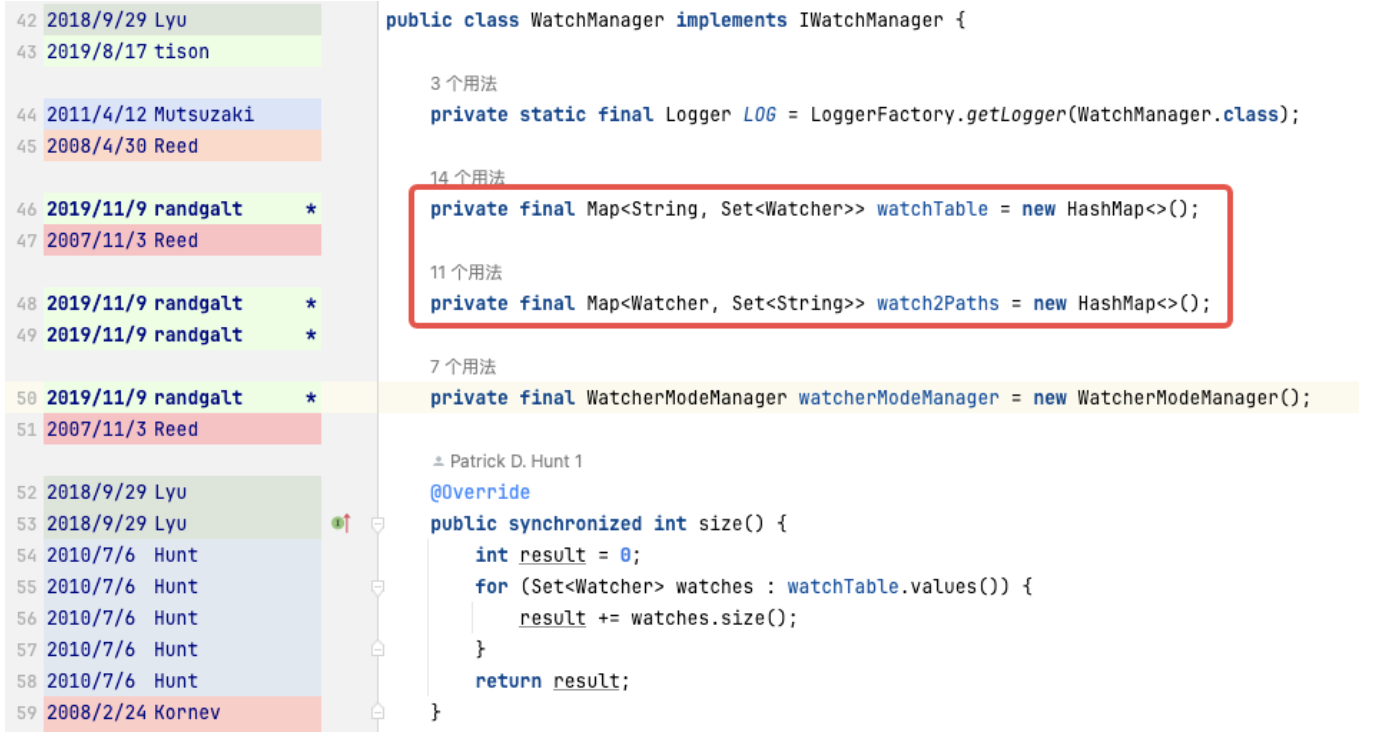
WatchTables [forward lookup table]
HashMap<ZNode, HashSet<Watcher>>
Scenario: When a ZNode changes, the Watcher subscribed to the ZNode will receive a notification.
Logic: Use this ZNode to find all corresponding Watcher lists through WatchTables, and then send notifications one by one.
Watch2Paths [reverse lookup table]
HashMap<Watcher, HashSet>
Scenario: Counting which ZNodes a certain Watcher has subscribed to
Logic: Use this Watcher to find all corresponding ZNode lists through Watch2Paths
Watcher is essentially NIOServerCnxn, which can be understood as a connection session.
If there are a large number of ZNodes and Watchers, and the client subscribes to a large number of ZNodes, it can even be fully subscribed. The relationship recorded in these two Hash tables will grow exponentially, and will eventually reach a huge amount!
When fully subscribed, as shown in the figure:
When the number of ZNodes: 3, the number of Watchers: 2, WatchTables and Watch2Paths will each have 6 relationships.
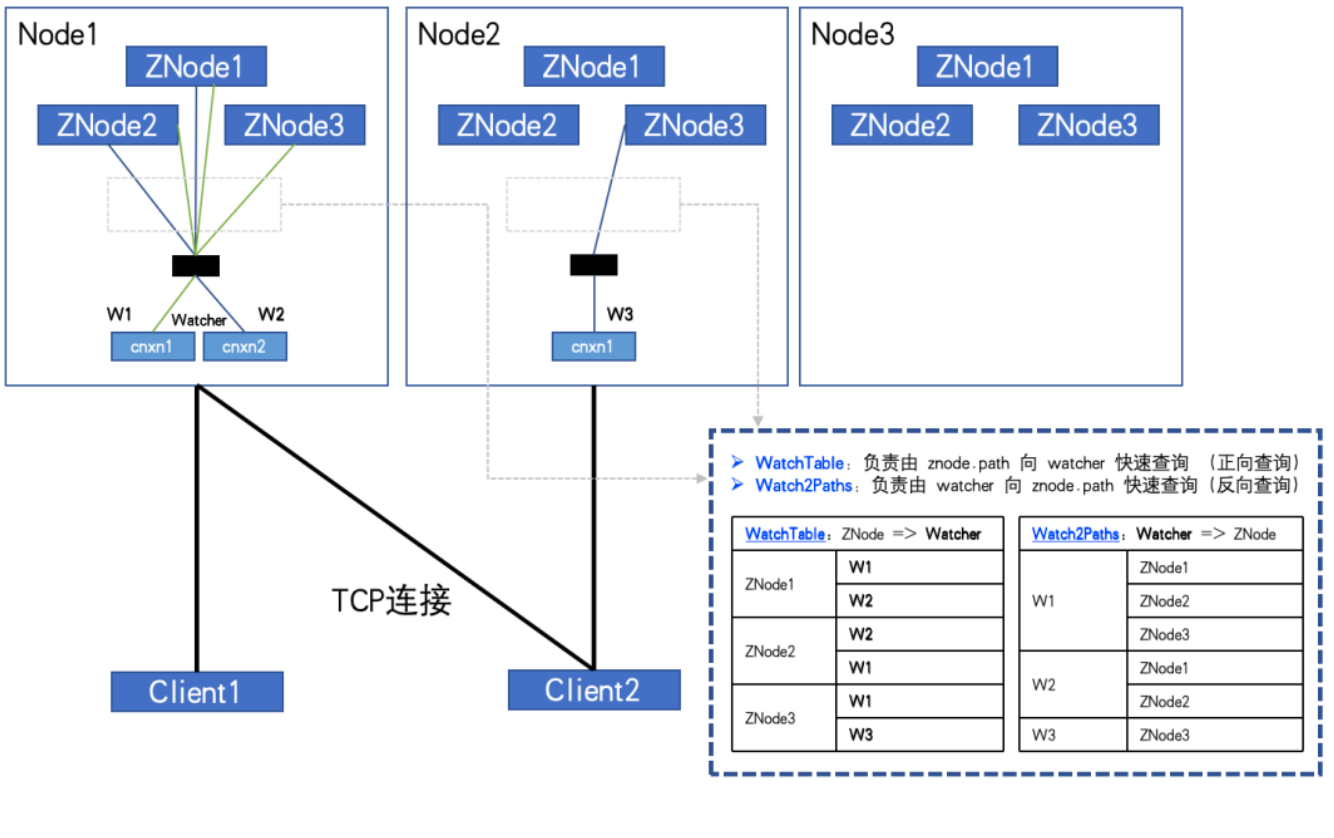
When the number of ZNodes: 4, the number of Watchers: 3, WatchTables and Watch2Paths will each have 12 relationships.
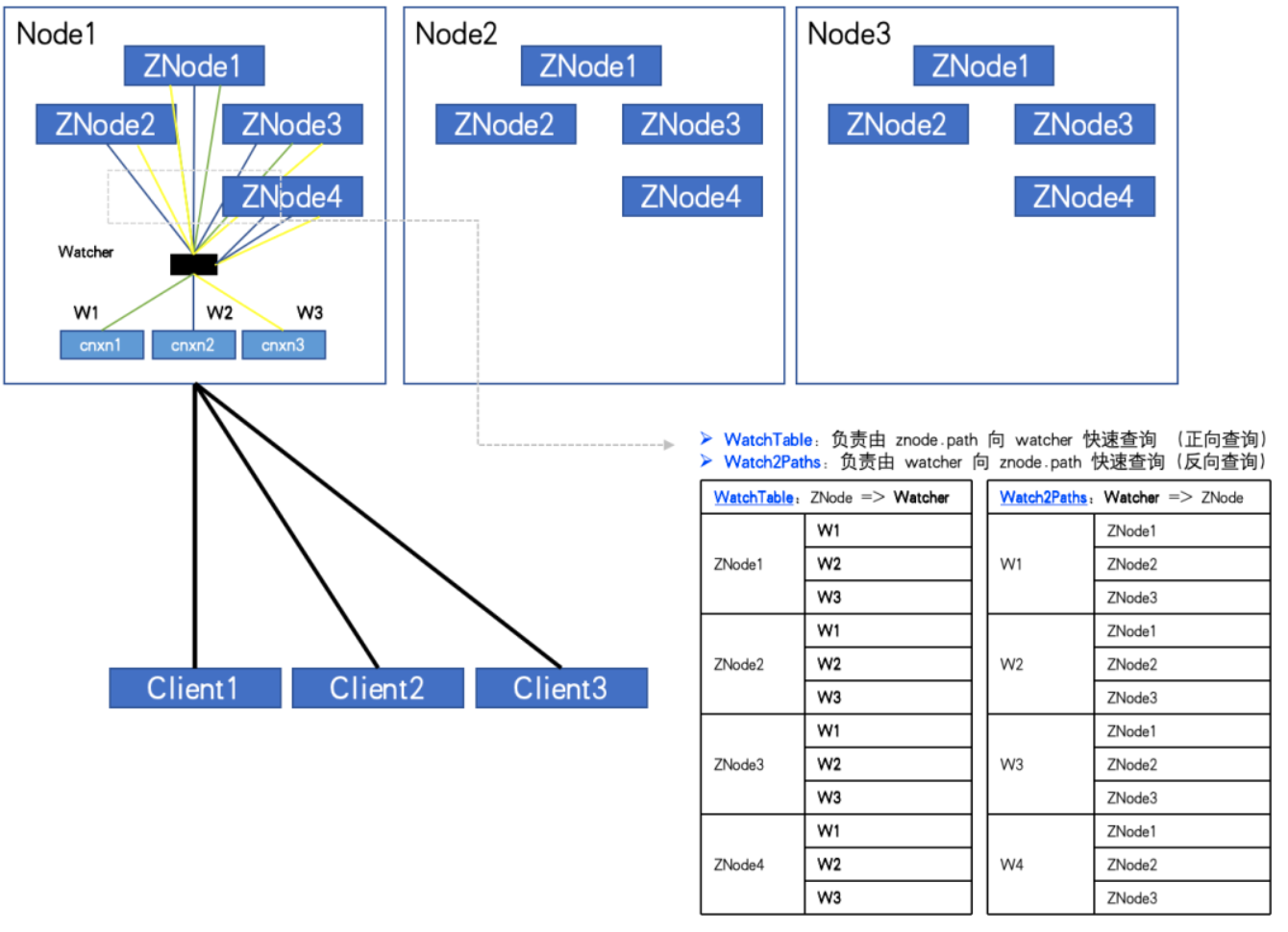
Through monitoring, we found an abnormal ZK-Node. The number of ZNodes is about 20W, and the number of Watchers is 5,000. The number of relationships between Watcher and ZNode has reached 100 million.
If one HashMap&Node (32Byte) is needed to store each relationship, since there are two relationship tables, double it. Then don't calculate anything else. This "shell" alone requires 2*10000^2*32/1024^3 = 5.9GB of invalid memory overhead.
At this point in the analysis, everyone should understand. Why is our ZK memory always walking a "tightrope" and often OOMs.
unexpected discovery
Now that we have identified the cause of the problem, we should next think about how to fix it.
From the above analysis, we can know that we need to avoid the client from fully subscribing to all ZNodes. However, the reality is that many business codes do have such logic to traverse all ZNodes starting from the root node of the ZTree and fully subscribe to them.
We may be able to convince some business parties to make improvements, but we cannot enforce the usage patterns of all business parties. Therefore, our approach to solving this problem lies in monitoring and prevention. However, unfortunately, ZK itself does not support such a function, which requires modification of the ZK source code.
Through tracking and analysis of the source code, we found that the source of the problem pointed to WatchManager, and we carefully studied the logical details of this class. After in-depth understanding, we found that the quality of this code seemed to be written by a recent graduate, and there were a lot of inappropriate use of threads and locks. By looking at the Git records, we found that this issue dates back to 2007. However, what is exciting is that during this period, WatchManagerOptimized (2018) appeared. By searching the ZK community’s information, we found [ZOOKEEPER-1177], that is, in 2011, the ZK community had already realized that a large number of Watch caused memory usage issues and finally provided a solution in 2018. It is precisely because of this WatchManagerOptimized that it seems that the ZK community has already optimized it.
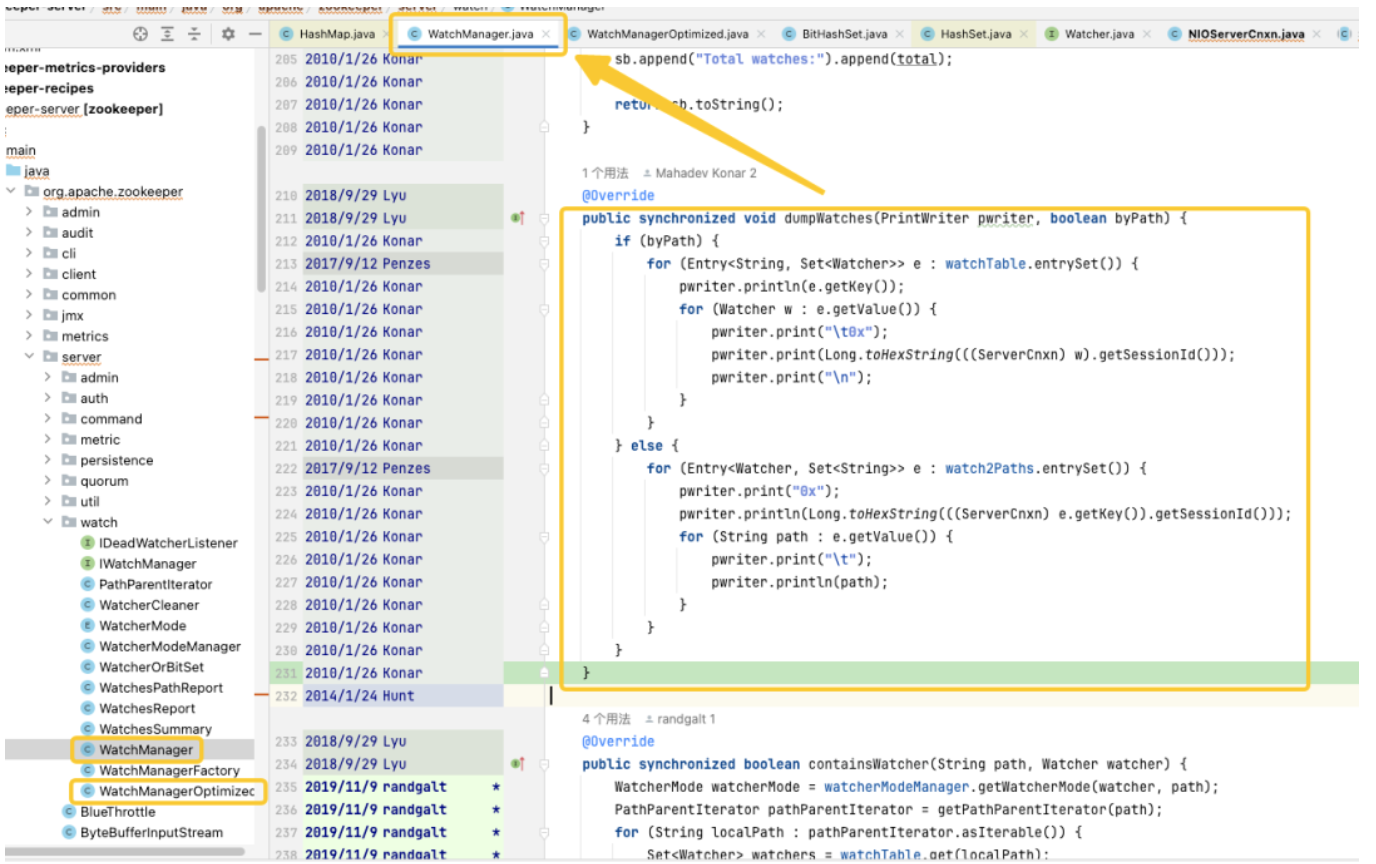
Interestingly, ZK does not enable this class by default, even in the latest 3.9.X version, WatchManager is still used by default. Perhaps because ZK is so old, people gradually pay less attention to it. By asking colleagues at Alibaba, we confirmed that MSE-ZK also enabled WatchManagerOptimized, which further confirmed that our focus was in the right direction. Therefore, we thought it was necessary to dig deeper into the potential of this class.
Optimize exploration
Lock optimization
In the default version, the HashSet used is thread-unsafe. In this version, related operation methods such as addWatch, removeWatcher and triggerWatch are all implemented by adding synchronized heavy locks to the methods. In the optimized version, we use a combination of ConcurrentHashMap and ReadWriteLock to use the lock mechanism in a more refined manner. In this way, more efficient operations can be achieved during the process of adding Watch and triggering Watch.
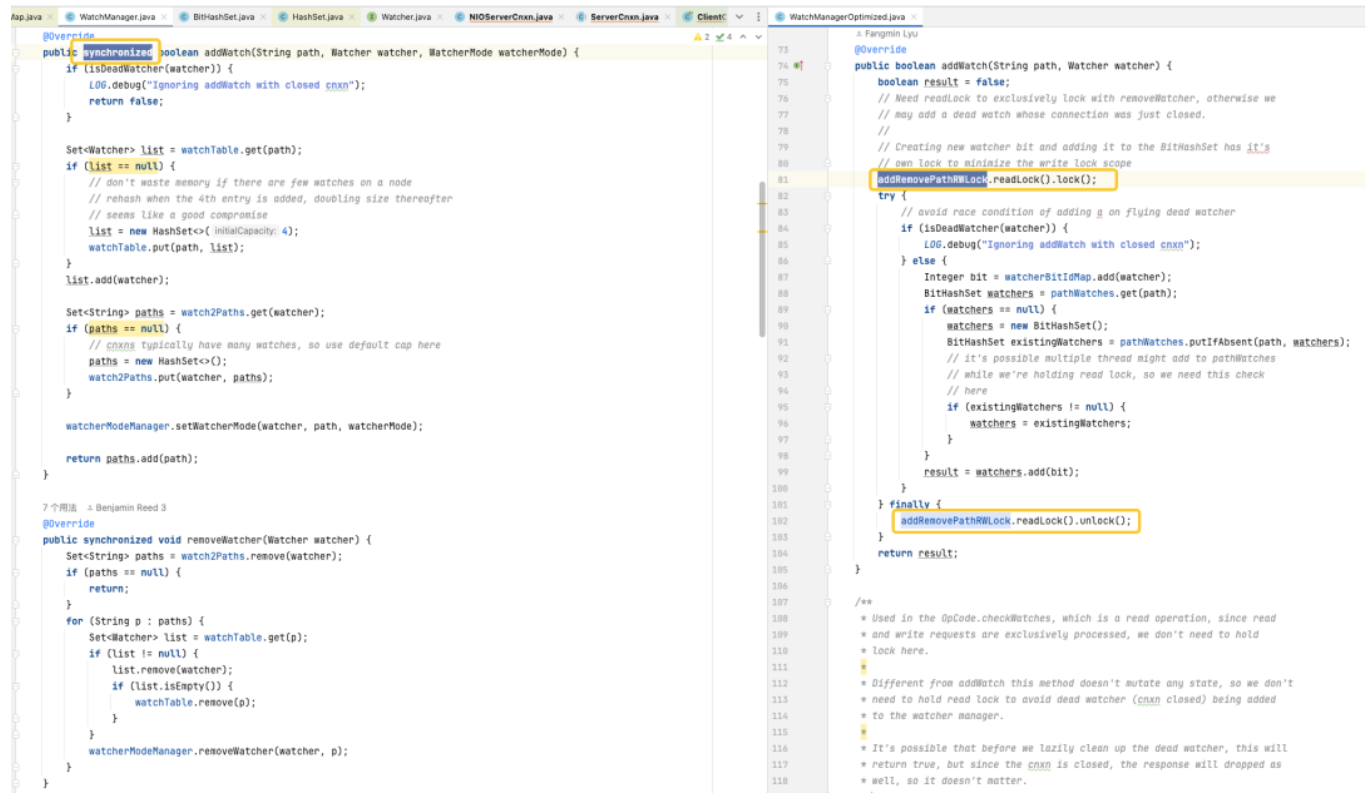
Storage optimization
This is our focus. From the analysis of WatchManager, we can see that the storage efficiency of using WatchTables and Watch2Paths is not high. If ZNode has many subscription relationships, a large amount of additional invalid memory will be consumed.
To our surprise, WatchManagerOptimized uses "black technology" -> bitmap here.
The relational storage is heavily compressed using bitmaps to achieve dimensionality reduction optimization.
Main features of Java BitSet:
-
Space efficient: BitSet uses bit arrays to store data, requiring less space than standard Boolean arrays.
-
Fast processing: Performing bitwise operations (such as AND, OR, XOR, flipping) is often faster than the corresponding Boolean logic operations.
-
Dynamic expansion: The size of a BitSet can dynamically grow as needed to accommodate more bits.
BitSet uses a long[] words to store data. The long type occupies 8 bytes and is 64 bits . Each element in the array can store 64 pieces of data. The storage order of data in the array is from left to right, from low to high .
For example, the BitSet in the figure below has a words capacity of 4. Words[0] from low to high indicates whether data 0~63 exists, words[1] from low to high indicates whether data 64~127 exists, and so on. Among them, words[1] = 8, and the corresponding binary bit 8 is 1, indicating that there is a data {67} stored in the BitSet at this time.

WatchManagerOptimized uses BitMap to store all Watchers. In this way, even if there is a 1W Watcher. The memory consumption of bitmap is only 8Byte*1W/64/1024= 1.2KB . If you change to HashSet, you will need at least 32Byte*10000/1024=305KB, and the storage efficiency will be nearly 300 times different.
WatchManager.java:private final Map<String, Set<Watcher>> watchTable = new HashMap<>();private final Map<Watcher, Set<String>> watch2Paths = new HashMap<>();
WatchManagerOptimized.java:private final ConcurrentHashMap<String, BitHashSet> pathWatches = new ConcurrentHashMap<String, BitHashSet>();private final BitMap<Watcher> watcherBitIdMap = new BitMap<Watcher>();
The mapping storage from ZNode to Watcher is changed from Map<string, set> to ConcurrentHashMap<string, BitHashSet >. That is to say, the Set is no longer stored, but the bitmap is used to store the bitmap index value.
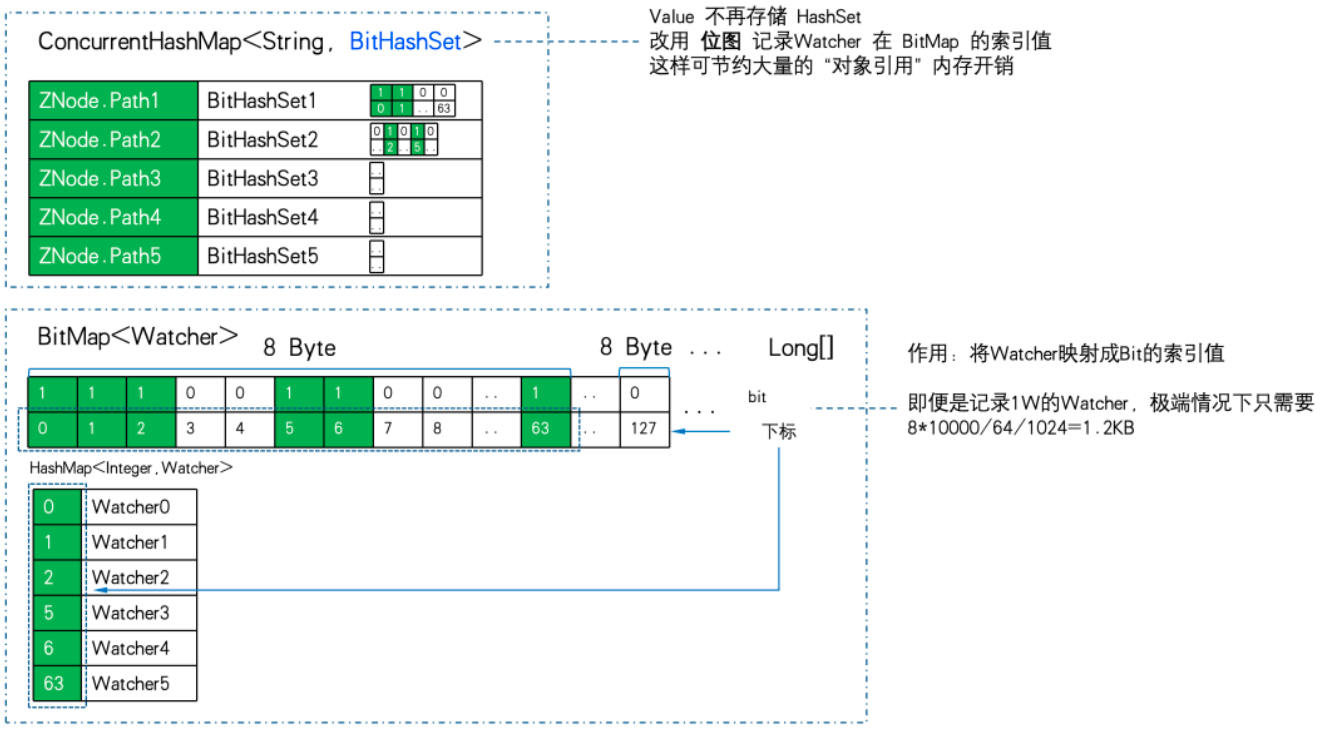
We use 1W ZNode, 1W Watcher, and at the extreme extreme use full subscription (all Watchers subscribe to all ZNodes) to do storage efficiency PK:

You can see that 11.7MB PK 5.9GB , the memory storage efficiency difference is: 516 times .
Logic optimization

-
Adding a monitor: Both versions are able to complete operations in constant time, but the optimized version provides better concurrency performance by using ConcurrentHashMap .
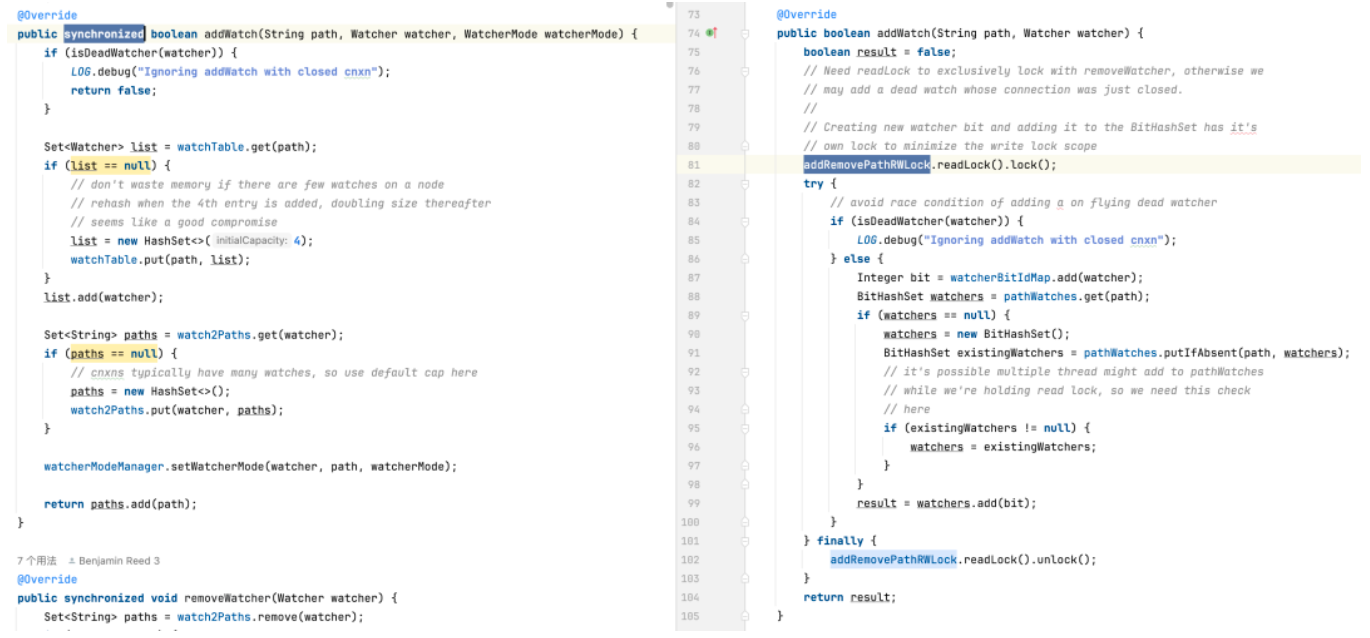
-
Deleting a monitor: The default version may need to traverse the entire monitor collection to find and delete the monitor, resulting in a time complexity of O(n). The optimized version uses BitSet and ConcurrentHashMap to quickly locate and delete monitors in O(1) in most cases.

-
Triggering monitors: The default version is more complex because it requires operations on every monitor on every path. The optimized version optimizes the performance of trigger monitors through more efficient data structures and reduced lock usage.
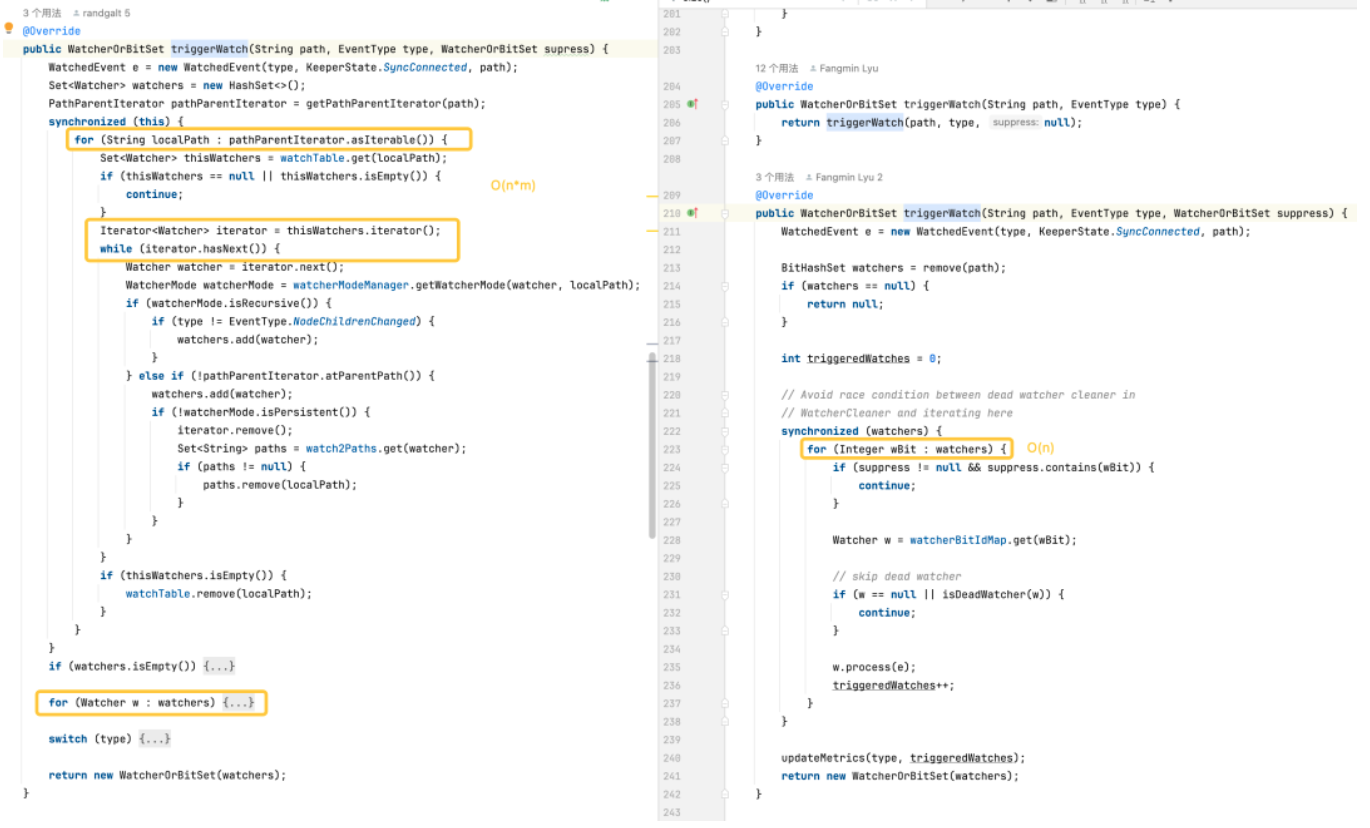
3. Performance stress test
JMH microbenchmark
Zookeeper 3.6.4 source code compilation, JMH micor stress test WatchBench.

pathCount: Indicates the number of ZNode paths used in the test.
watchManagerClass: Represents the WatchManager implementation class used in the test.
watcherCount: Indicates the number of observers (Watchers) used in the test.
Mode: Indicates the test mode, here is avgt, which indicates the average running time.
Cnt: Indicates the number of test runs.
Score: Indicates the score of the test, that is, the average running time.
Error: Indicates the error range of the score.
Units: The unit representing the score, here is milliseconds/operation (ms/op).
-
There are 1 million subscriptions between ZNode and Watcher. The default version uses 50MB, and the optimized version only requires 0.2MB, and it will not increase linearly.
-
Adding Watch, the optimized version (0.406 ms/op) is 6.5 times faster than the default version (2.669 ms/op).
-
A large number of Watches are triggered, and the optimized version (17.833 ms/op) is 5 times faster than the default version (84.455 ms/op).
Performance stress test
Next, we built a set of 3-node zookeeper 3.6.4 on a machine (32C 60G), using the optimized version and the default version to perform capacity stress testing comparison.
Scenario 1: 20W znode short path
Znode short path: /demo/znode1

Scenario 2: 20W znode long path
Znode long path: /sentinel-cluster/dev/xx-admin-interfaces/lock/_c_bb0832d5-67a5-48ab-8fe0-040b9ddea-lock/12

-
Watch memory usage is related to the Path length of ZNode.
-
The number of Watches increases linearly in the default version and performs very well in the optimized version, which is a very obvious improvement for memory usage optimization.
Grayscale test
Based on the previous benchmark test and capacity test, the optimized version has obvious memory optimization in a large number of Watch scenarios. Next, we started to conduct grayscale upgrade test observations on the ZK cluster in the test environment.
The first zookeeper cluster & benefits

Default version
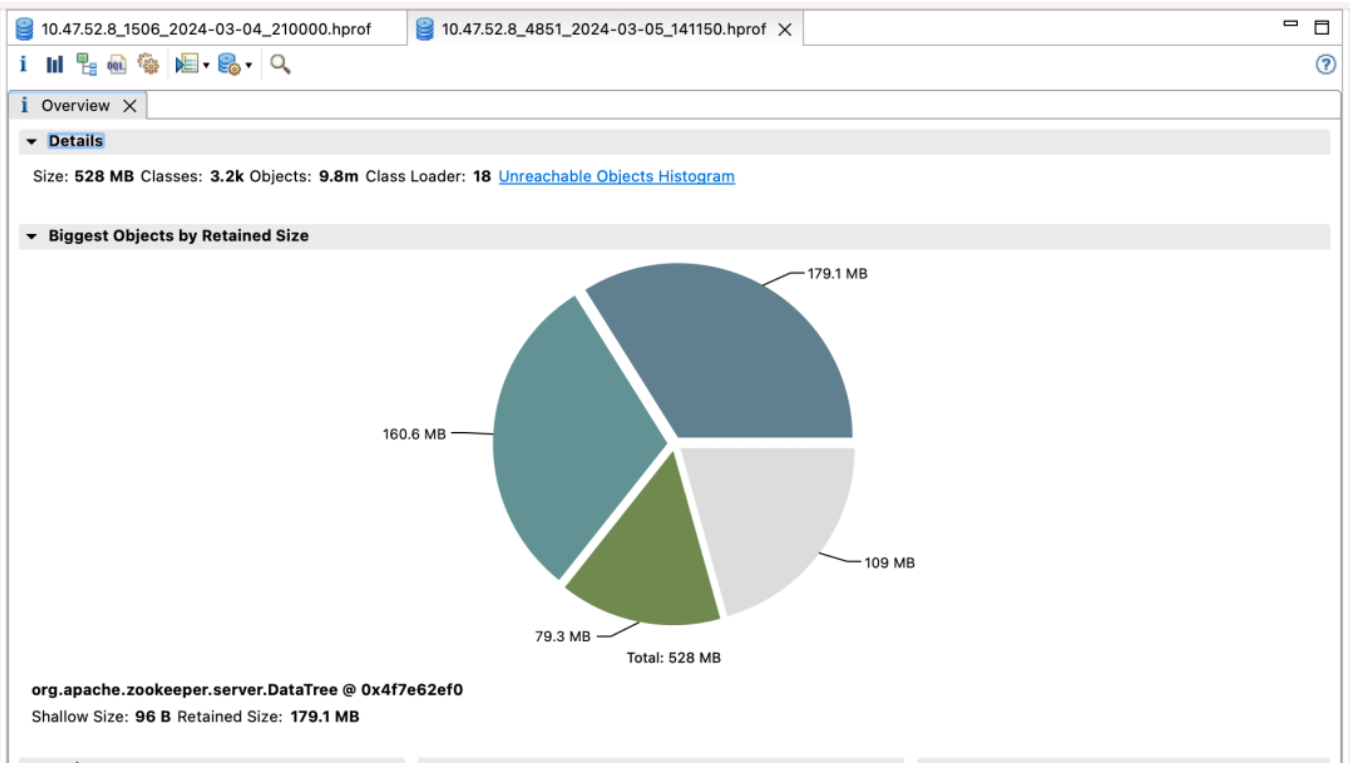
Optimized version
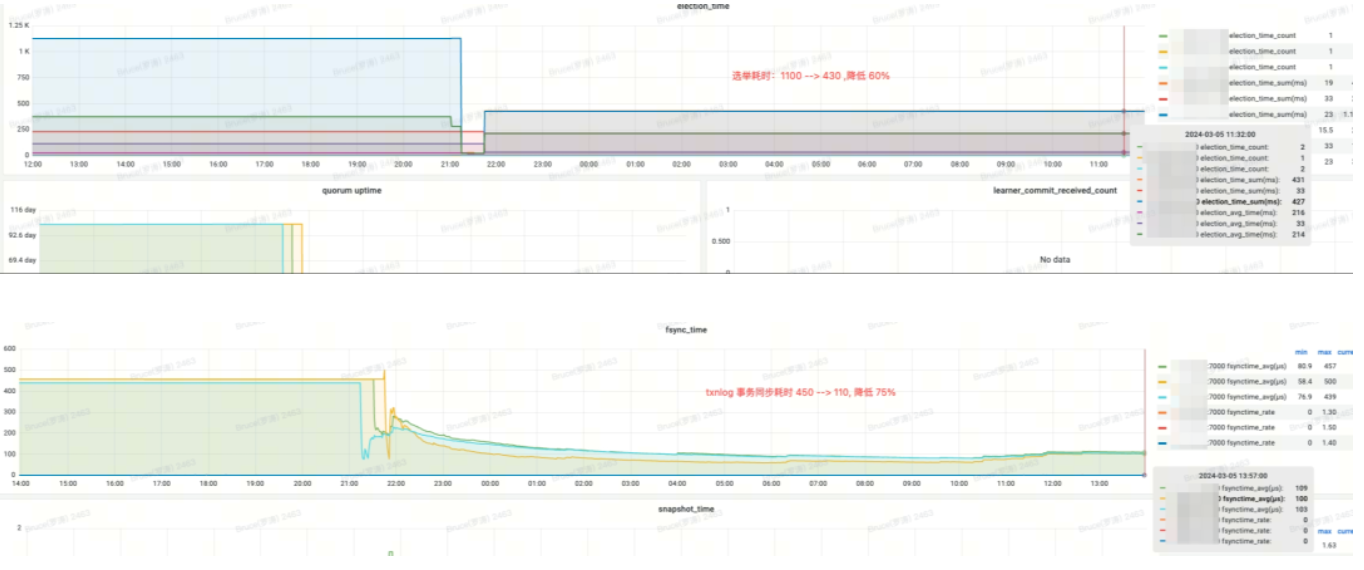
Effect income:
-
election_time (election time): reduced by 60%
-
fsync_time (transaction synchronization time): reduced by 75%
-
Memory usage: reduced by 91%
The second zookeeper cluster & benefits
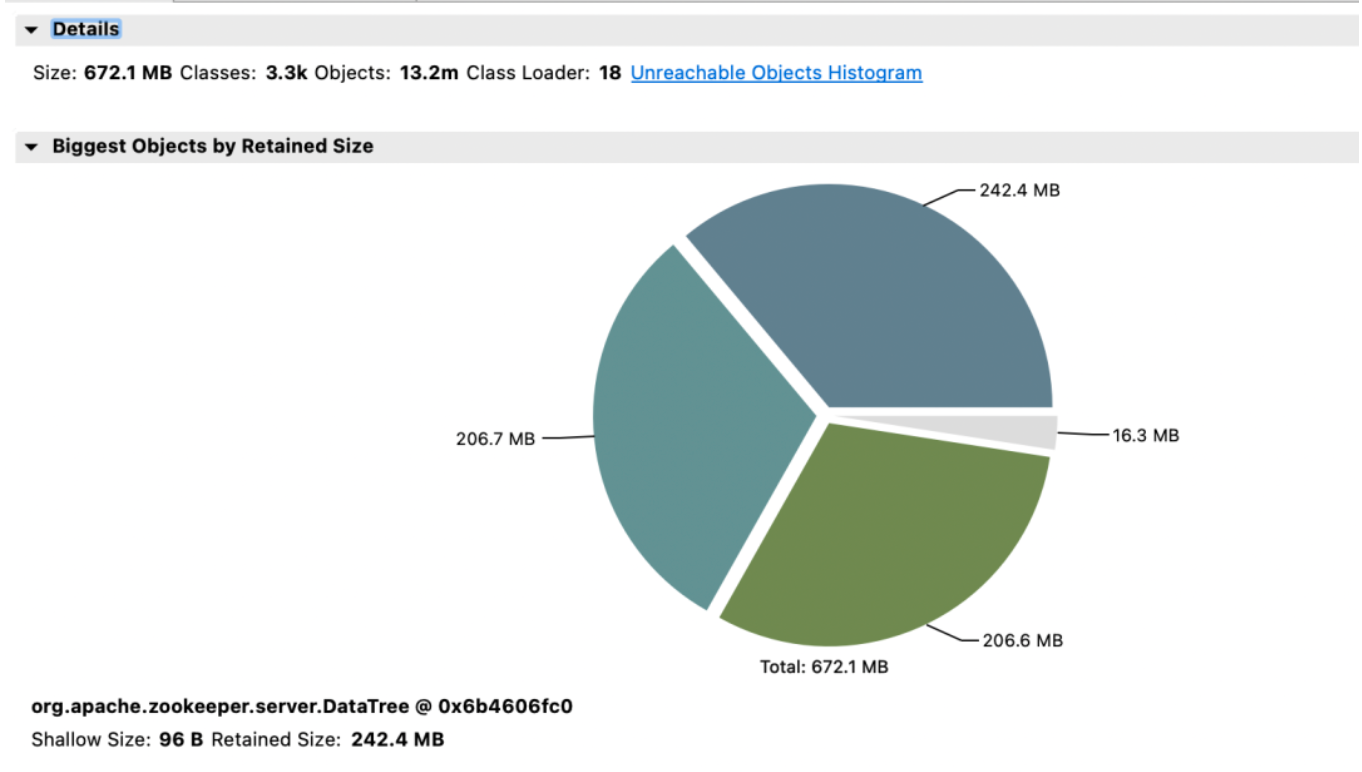
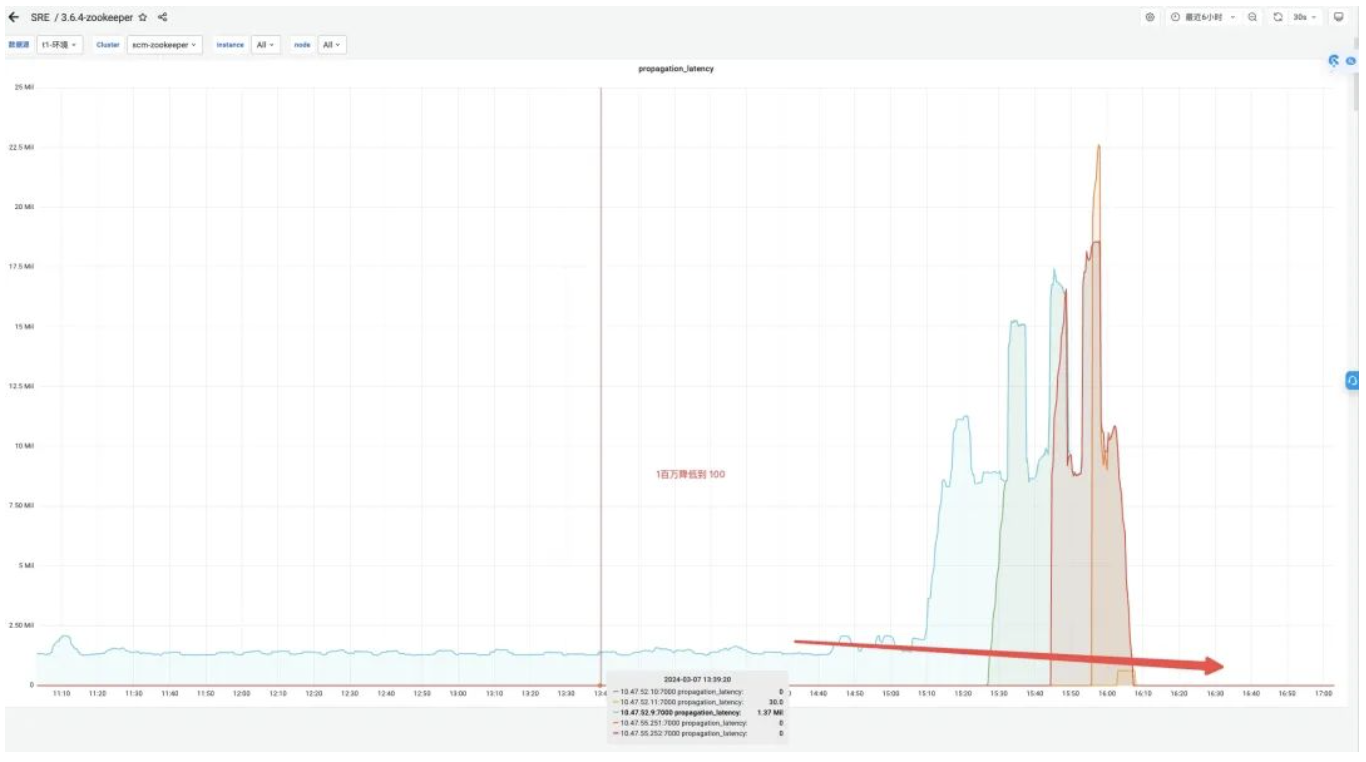

Effect income:
-
Memory: Before the change, the JVM Attach response failed to respond and data collection failed.
-
election_time (election time): reduced by 64%.
-
max_latency (read latency): reduced by 53%.
-
proposal_latency (election processing proposal delay): 1400000 ms --> 43 ms.
-
propagation_latency (data propagation delay): 1400000 ms --> 43 ms.
The third set of zookeeper cluster & benefits
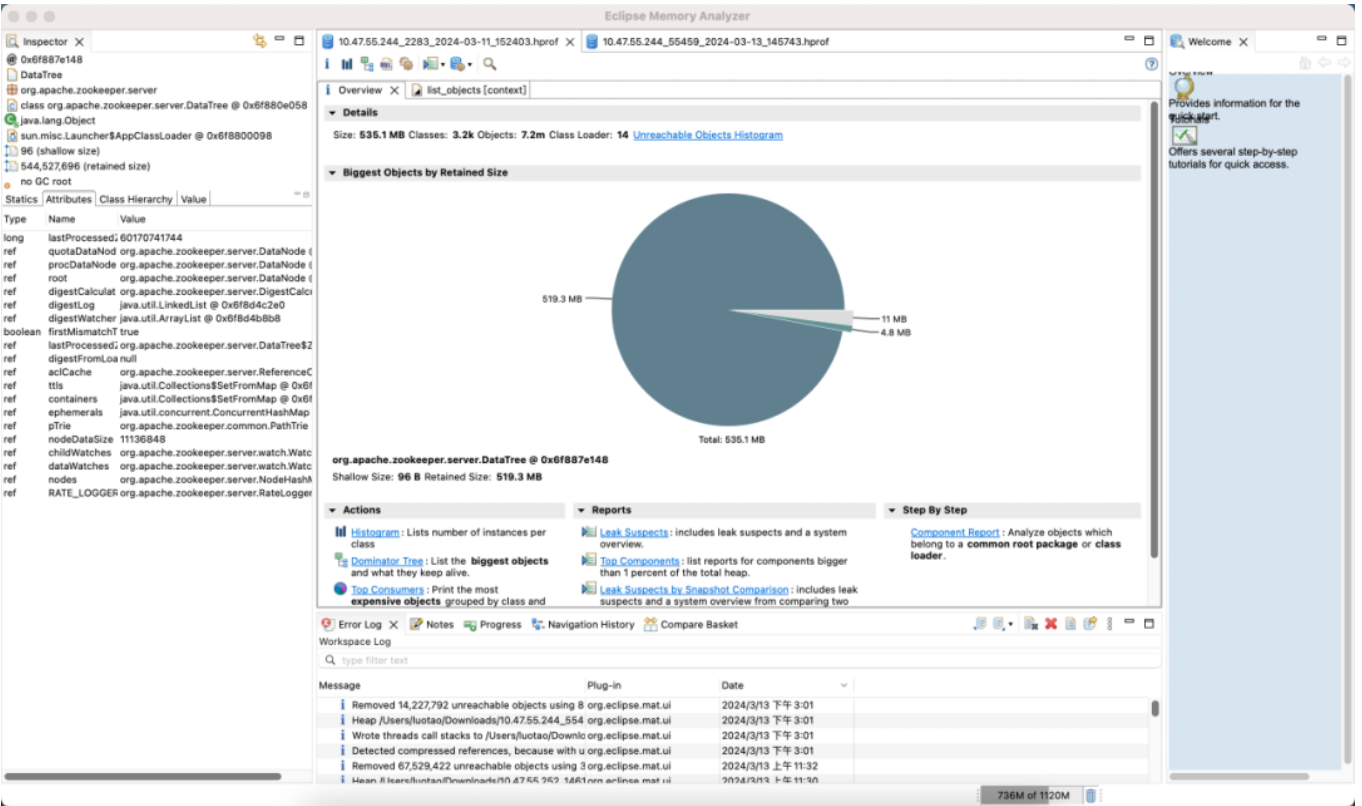
Default version
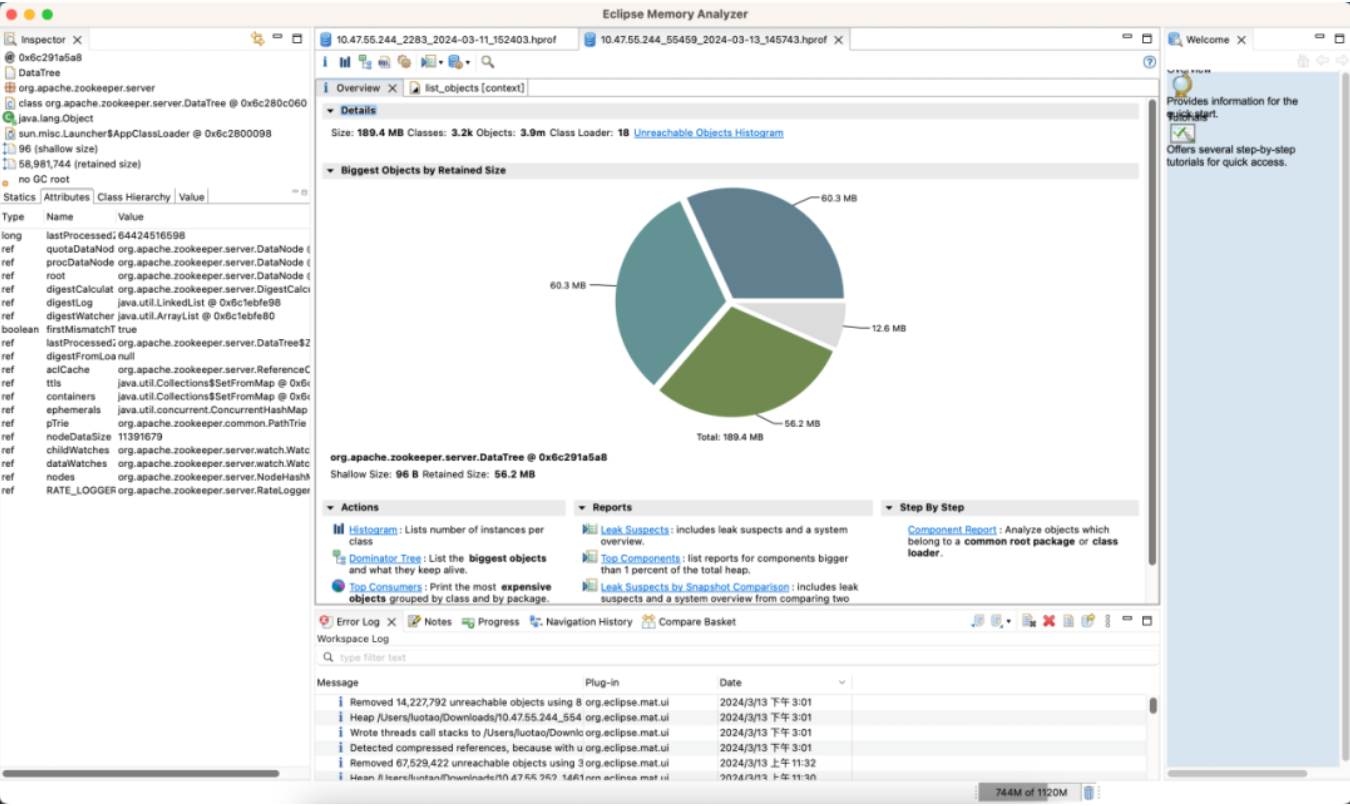
Optimized version
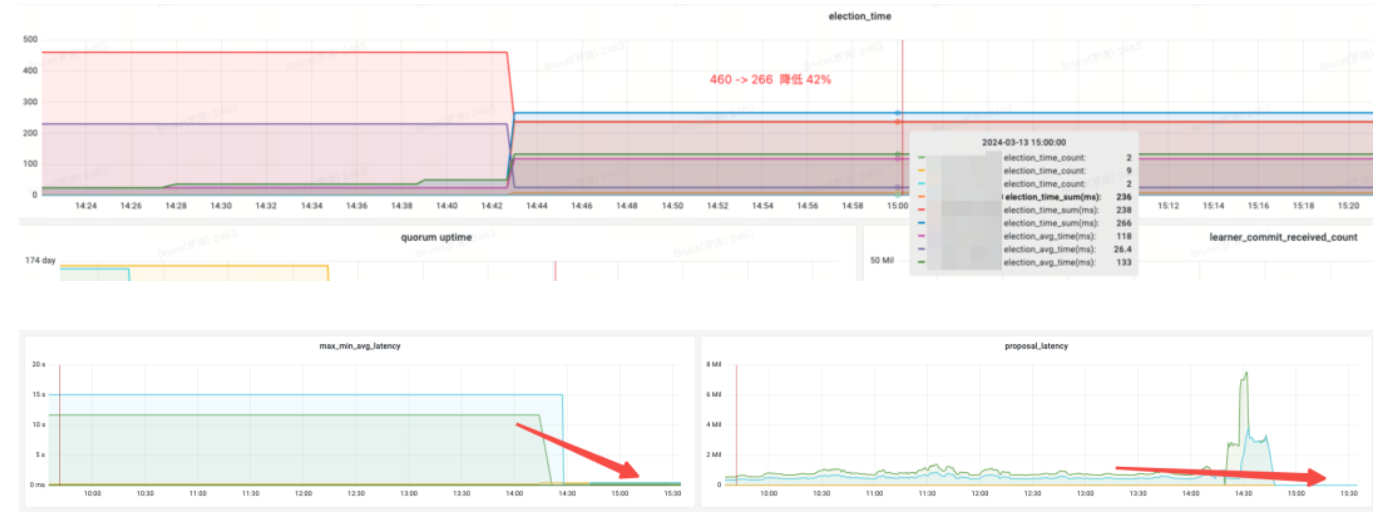
Effect income:
-
Memory: Save 89%
-
election_time (election time): reduced by 42%
-
max_latency (read latency): reduced by 95%
-
proposal_latency (election processing proposal delay): 679999 ms --> 0.3 ms
-
propagation_latency (data propagation delay): 928000 ms--> 5 ms
4. Summary
通过之前的基准测试、性能压测以及灰度测试,我们发现了 Zookeeper 的 WatchManagerOptimized。这项优化不仅节省了内存,还通过锁的优化显著提高了节点之间的选举和数据同步等指标,从而增强了 Zookeeper 的一致性。我们还与阿里MSE的同学进行了深度交流,各自在极端场景模拟压测,并达成了一致的看法:WatchManagerOptimized 对 Zookeeper 的稳定性提升显著。总体而言,这项优化使得 Zookeeper 的 SLA 提升了一个数量级。
ZooKeeper has many configuration options, but in most cases no adjustment is required. To improve system stability, we recommend the following configuration optimizations:
-
Mount dataDir (data directory) and dataLogDir (transaction log directory) to different disks respectively, and use high-performance block storage.
-
For ZooKeeper version 3.8, it is recommended to use JDK 17 and enable the ZGC garbage collector; for versions 3.5 and 3.6, it is recommended to use JDK 8 and enable the G1 garbage collector. For these versions, simply configure -Xms and -Xmx.
-
将 SnapshotCount 参数默认值 100,000 调整为 500,000,这样可以在高频率 ZNode 变动时显著降低磁盘压力。
-
Use the optimized version of Watch Manager WatchManagerOptimized.
Ref:
https://issues.apache.org/jira/browse/ZOOKEEPER-1177
https://github.com/apache/zookeeper/pull/590
*Text/ Bruce
This article is original to Dewu Technology. For more exciting articles, please see: Dewu Technology official website
Reprinting without the permission of Dewu Technology is strictly prohibited, otherwise legal liability will be pursued according to law!
The first major version update of JetBrains 2024 (2024.1) is open source. Even Microsoft plans to pay for it. Why is it still being criticized for open source? [Recovered] Tencent Cloud backend crashed: A large number of service errors and no data after logging in to the console. Germany also needs to be "independently controllable". The state government migrated 30,000 PCs from Windows to Linux deepin-IDE and finally achieved bootstrapping! Visual Studio Code 1.88 is released. Good guy, Tencent has really turned Switch into a "thinking learning machine". RustDesk remote desktop starts and reconstructs the Web client. WeChat's open source terminal database based on SQLite, WCDB, has received a major upgrade.